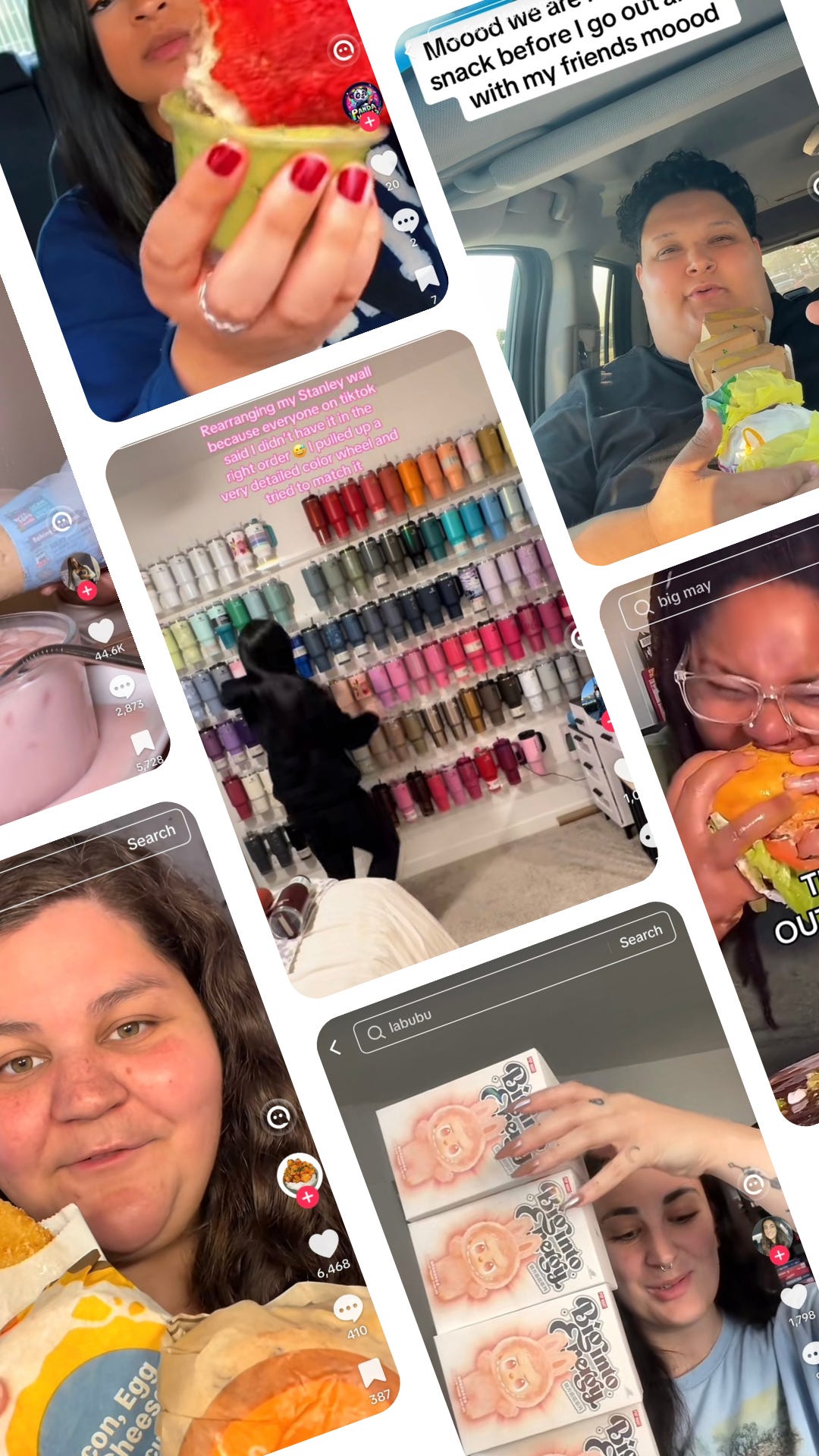i am so full and so empty at the same time
on mukbangs, labubus, and the grind that never stops
We live in a hungry culture. Hungry for food, cheap gas, and ugly, inanimate objects that dangle from a Shein purse.
Capitalism has tricked us. Tricked me, even. It convinces us that this deep hunger can only be satiated by the art of spending. We tell ourselves we thrift because it’s cheap and ecological. We justify trips to Marshalls because discount shopping can’t be that bad.
There’s an entire demographic of women on TikTok who compete for the most disgusting and outrageous mukbang. Women buy pounds of food to solo devour, with a microphone clipped to their chest.
They eat in their cars, fry their Chipotle burritos in sugar, or dye them candy-apple red—all so you’ll like, comment, and follow. People spend $50 at Dunkin’ Donuts, buy enough food to feed their entire office floor, and gobble it up like a little piggy within twenty minutes.
But I don’t just watch these rituals—I’ve lived them.
My hunger didn’t go viral, but it shaped my entire early adulthood.
I didn’t just consume content. I consumed to survive.
This greed highlights a pertinent issue: we are so full, yet so hungry at the same time.
My own personal relationship with gluttony stemmed from the black hole that used to reside inside me. I hated my life. I hated myself. It felt like my real life was waiting out there, somewhere—and I couldn’t figure out how to get to it.
I graduated high school, and I ate. And I ate. I ordered takeout constantly. I didn’t know how to cook. And I gained. Before I realized it, I had ballooned up to 312 pounds.
It took a long time for me to admit that when I looked in the mirror, I didn’t like what stared back. It wasn’t necessarily the weight—trust me, I didn’t even think I was that big. Rather, it was almost like my insides—my self-hatred, my shame—had all found their way to the external: my physical appearance.
If I wanted to change, I had to change my relationship with food. I sought out medical help, saw a dietitian, and changed my habits. I learned to exercise for the movement of it all—to get comfortable with experiencing myself and how I live inside my body.
But I was still hungry.
Not for food, per se—but that black hole still craved something. Validation. Time. Attention. I was no longer getting my dopamine hit from eating. I still needed more.
So I shopped. And I spent money I didn’t have. I collected CDs (still do, hehe). I bargain-shopped at Marshalls for things I didn’t need. Left Savers with bags full of clothes. Told myself I wanted to start a new project. Wanted to learn how to do my makeup. I found myself in Ulta. Sephora. Target. Ten dollars. Twenty dollars. Thirty. Swipe. Tap. Insert.
And when I would pull into my driveway, I would be filled with regret and drowning in excess.
Being chronically online only made my problem worse. But it made me think.
We cannot speed-build our lives through consumption. Generation Z seems to believe that if we buy cool, quirky things, we can absorb their powers—and they’ll reward us with a personality.
Clean girl. Cool girl. Grandpa-core. Coastal grandmother. Coastal granddaughter. Pilates princess. Mob wife-core. Coquette. Tomato girl. Sade girl. Labubu. Trinkets. Stanleys.
Who are you?
The missing puzzle piece to life is this: you must live your life to be considered cool.
You must travel. You must explore. You must buy the ugly refrigerator magnet on your trip. The keychain. The shirt.
You must exchange these things. Maybe lose them.
That is coolness.
We’re hungry for meaning. For self-worth. Mukbangs are just a response to late-stage capitalism. Most of us can’t justify a $50 Stanley Cup purchase—but we can make sense of a $50 meal from McDonald’s.
Addictions don’t always present as some debilitating illness—and that’s how we sometimes get so lost in them. We believe that if we buy the Stanley Cup or the Labubu, it’s a signal of status. A signifier of wealth. A shortcut to being perceived the way we want to be.
And maybe that’s what we’re really consuming—not the thing itself, but the hopeful possibility of a self.



